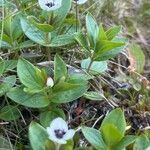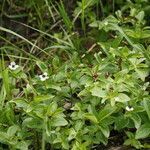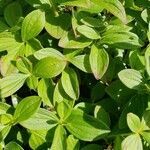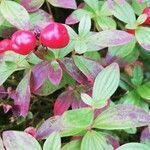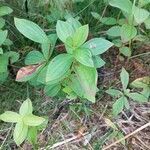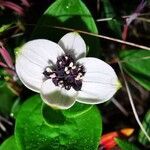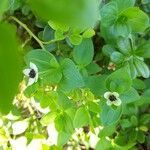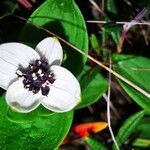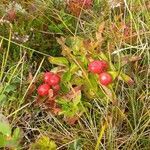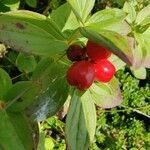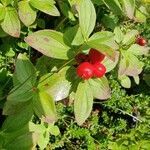Stems erect, green, 5–22 cm, appressed-hairy; nodes 4–7, internodes only slightly longer distally; branches at distal 1–3 nodes, ca. as long as distal internodes. Leaves at basal node nonchlorophyllous, opposite, scalelike, caducous, at remaining nodes chlorophyllous, opposite, well developed, persistent; distalmost leaves similar in size to those at 2 more proximal nodes; petiole 0–7.5 mm; blade ovate or oval, 1.3–4 × 0.7–2.8 cm, apex broadly acute or obtuse, abaxial surface pale green, moderately appressed-hairy, adaxial surface bluish green, appressed-hairy; secondary veins 3 per side, all arising from near base, occasionally distalmost vein bifurcating in basal 1/5. Inflorescences 5–17-flowered; peduncle 8–20 mm; primary branches 0–0.4 mm; bracts white, often red-or purple-tinged, ± equal, ovate, 8–12 × 4–7.5 mm, apex slightly acute. Pedicels 0.7–1.5 mm, moderately appressed-hairy proximally, densely at base of hypanthium. Flowers: hypanthium deep purple, 1–2 mm, very sparsely appressed-hairy; sepals deep purple, 0.2–0.5 mm, apex acute, thick, densely hairy on margins, densely glandular; petals purple, 1.2–1.5 mm, apical awn 0.5 mm; nectary purple or black. Drupes 3–8 per infructescence, red, globose, 5–8 mm; stone usually globose, 2.1–3.4 mm diam., longitudinally grooved, apex rounded. 2n = 22.
More
Much like no. 8 [Cornus canadensis L.]; stems 5–15 cm, regularly bearing a few pairs of cauline lvs as well as the terminal cluster or pair and often emitting lateral branches from their axils; lvs sessile; lateral veins usually 2 pairs, arising from or very near the base of the lf; bracts white, 1 cm; fls dark purple; stone lightly grooved, bilocular; 2n=22. Wet woods and rocks; circumboreal, s. in Amer. to Nf., N.S., and Que. (Chamaepericlymenum s.)
A shrubby plant. It keeps growing from year to year. It has an underground rhizome that sends out suckers. The stems grow from this. It grows 30 cm high. There are 3-6 pairs of pale green rounded leaves. The flowers have 4 white bracts with a small purplish black flower in the centre. There are 3-10 bright red berries at the top. They are about 1 cm across.
In groups or forming pure thickets in open damp, mossy forests, particularly birch, shrubby thickets, maritime heath, moorland, tundra, or copse, along streams, peat banks, bogs, marshes; at elevations up to 900 metres.
More
Temperate. It grows on dry and rocky sites in the Arctic in Asia and Europe. It grows best in moist acidic soils.
